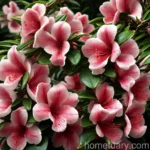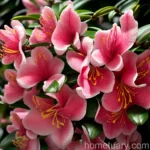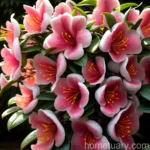Azalea (Rhododendron ‘Viscosepala’): A Comprehensive Guide to Care and Cultivation
The azalea (Rhododendron ‘Viscosepala’) is a stunning flowering plant that belongs to the family Ericaceae. Azaleas are known for their vibrant and colorful blooms, making them a popular choice for gardens, landscapes, and indoor settings. In this comprehensive guide, we will delve into the key aspects of azalea care and cultivation, including cultural requirements, uses, propagation, common diseases and pests, and much more.
What is Azalea (Rhododendron ‘Viscosepala’)?
The azalea, known botanically as Rhododendron ‘Viscosepala’, is a species of flowering plant that is valued for its attractive and showy flowers. This particular variety is known for its striking beauty and has gained popularity among gardeners and horticulturists for its ornamental value.
Azaleas are native to several regions across the globe, including Asia, North America, and Europe. They are known for their diverse range of flower colors, including shades of pink, red, purple, white, and orange. The foliage of azaleas also varies in color and texture, adding to their overall aesthetic appeal.
Key Takeaways – Azalea (Rhododendron ‘Viscosepala’)
Before we delve into the specifics of azalea care and cultivation, let’s highlight some key takeaways about this beautiful plant:
- Scientific Name: Rhododendron ‘Viscosepala’
- Family: Ericaceae
- Native Habitat: Asia, North America, Europe
- Flower Colors: Pink, red, purple, white, orange
- Foliage: Varied colors and textures
- Use: Ornamental plant for gardens, landscapes, and indoor settings
Now that we have a brief introduction to the azalea plant, let’s explore the various aspects of caring for and cultivating this stunning species.
Culture
Cultivating azaleas successfully requires an understanding of their cultural requirements, which include aspects such as water, sunlight, fertilizer, soil, pruning, and propagation.
Uses
Before diving into the specific cultural requirements, let’s consider the various uses of azalea plants:
- Ornamental Gardens: Azaleas are commonly used as ornamental plants in gardens and landscapes, adding vibrant colors and visual interest to outdoor spaces.
- Indoor Décor: Some varieties of azaleas can be grown indoors as potted plants, providing a splash of color and natural beauty within homes and offices.
- Cut Flowers: The eye-catching blooms of azaleas make them suitable for use in floral arrangements, adding a touch of elegance to bouquets and displays.
Water
Proper watering is crucial for the health and vitality of azaleas. Here are some essential considerations regarding water requirements:
- Moisture Levels: Azaleas prefer moist, well-drained soil. It’s important to ensure that the soil is consistently moist but not waterlogged.
- Frequency: During the growing season, regular watering is necessary, especially during dry periods. However, overwatering should be avoided to prevent root rot and other water-related issues.
- Water Quality: Azaleas are sensitive to water quality, and they thrive best with soft, slightly acidic water. If the natural water source is hard or alkaline, rainwater or filtered water may be preferable for watering azaleas.
Sunlight
Azaleas have specific sunlight requirements for optimal growth and flowering. Understanding their needs for sunlight is vital for their overall health:
- Light Levels: Azaleas thrive in partial shade to dappled sunlight. While they can tolerate some direct sunlight, prolonged exposure to intense sun may cause leaf scorch and reduce flowering.
- Morning Sun: Morning sunlight is generally well-tolerated by azaleas, providing the necessary energy for photosynthesis without the risk of heat stress.
Fertilizer
Fertilizing azaleas can enhance their growth, blooming, and overall vigor. Here are some considerations for fertilizing these plants:
- Acidic Fertilizer: Azaleas require acidic soil conditions, and the use of a specialized acidic fertilizer formulated for acid-loving plants is recommended.
- Timing: Fertilize azaleas in early spring before new growth begins, and then again after the first flush of flowers has faded. Avoid late-season fertilization, as it may stimulate new growth that could be vulnerable to frost damage.
Soil
The right soil conditions are crucial for the health and well-being of azaleas. Understanding the soil requirements is essential for successful cultivation:
- Acidic Soil: Azaleas thrive in acidic soil with a pH range between 4.5 and 6.0. Amending the soil with organic matter, such as pine bark or peat moss, can help maintain proper acidity levels.
- Well-Draining Soil: Good drainage is essential to prevent waterlogging, which can lead to root rot. Sandy loam or loamy soils with excellent drainage properties are ideal for azaleas.
Pruning
Pruning is an important aspect of azalea care, helping to maintain plant shape, control size, and stimulate new growth and flowering:
- Timing: Prune azaleas immediately after flowering to avoid cutting off the developing flower buds for the next season. Early summer is generally a suitable time for pruning.
- Deadheading: Removing spent flowers can encourage the development of new buds and promote ongoing flowering.
Propagation
While azaleas can be propagated from seeds, the most common methods of propagation include cuttings and layering. These techniques offer a way to reproduce specific qualities and traits of existing azalea plants:
- Cuttings: Propagate azaleas from stem cuttings taken from healthy, actively growing plants. Rooting hormone may be used to encourage successful root development.
- Layering: Layering involves encouraging a lower branch of the plant to form roots while it is still attached to the parent plant. Once roots have developed, the new plant can be separated and transplanted.
Container Popularity
Azaleas are well-suited for container gardening, making them a popular choice for those with limited garden space or for those who wish to showcase these beautiful plants on patios, balconies, and other outdoor areas. The compact and colorful nature of azaleas makes them ideal for container cultivation, allowing for easy mobility and versatility in design.
When selecting containers for azaleas, it’s important to choose options that provide good drainage and sufficient space for root development. Additionally, using an acidic potting mix designed for acid-loving plants is essential for maintaining the proper soil conditions within the containers.
Container Common Diseases
While container gardening offers many advantages, it’s important to be aware of the potential diseases that may affect azaleas grown in containers. Common diseases that can impact container-grown azaleas include:
- Root Rot: Overwatering and poor drainage can lead to root rot, causing the roots to become saturated and oxygen-deprived, ultimately leading to plant decline.
- Powdery Mildew: This fungal disease can appear as a white powdery coating on the leaves and stems, affecting the overall health and aesthetics of the plant.
- Leaf Spot: Leaf spot diseases, caused by various fungal pathogens, can lead to the development of dark or discolored spots on azalea leaves, potentially impacting plant vigor.
Disease Diagnosis
Diagnosing and addressing diseases in container-grown azaleas requires careful observation and prompt action. Key points to consider for disease diagnosis and management include:
- Symptom Recognition: Carefully observe the plant for any signs of abnormality, including discoloration, wilting, distortion, or unusual growth.
- Diagnostic Tools: Utilize resources such as plant pathology guides, extension services, and horticultural experts to assist in identifying specific diseases and their management.
Common Pests
In addition to diseases, azaleas can also be susceptible to various pests, especially when grown in containers. Understanding the common pests and their management is crucial for maintaining healthy azalea plants:
- Aphids: These small, soft-bodied insects can cluster on the tender new growth of azaleas, feeding on plant sap and potentially causing damage.
- Spider Mites: These tiny pests can infest azaleas, leading to webbing on the leaves and a decline in plant health.
- Azalea Lace Bug: This pest targets the foliage of azaleas, causing stippling, yellowing, and reduced vigor.
To manage pest infestations, consider employing integrated pest management (IPM) strategies, which may include methods such as insecticidal soaps, horticultural oils, beneficial predators, and cultural controls to minimize pest populations.
Botanist’s Tips
In addition to the fundamental care considerations for azaleas, here are a few expert tips to further enhance the cultivation and enjoyment of these beautiful plants:
- Create a naturalistic setting for azaleas by incorporating companion plants that complement their color and texture, such as ferns, hostas, and other shade-tolerant species.
- Ensure that azaleas receive appropriate winter care, especially in colder climates, by providing protection from harsh winds, heavy snow, and drastic temperature fluctuations.
Fun Facts
To add a bit of botanical trivia to your knowledge of azaleas, here are some fun facts about these captivating plants:
- The word “azalea” is derived from the Greek word “azaleos,” which means “dry” in reference to the plants’ preference for well-drained soil.
- Azaleas are a symbol of womanhood and femininity in various cultures, representing delicate beauty and elegance.
Now that we’ve explored the key aspects of azalea care and cultivation, if you’d like to further expand your knowledge and expertise on this topic, feel free to explore the following external resources:
In conclusion, the azalea (Rhododendron ‘Viscosepala’) stands as a captivating and versatile plant with much to offer in terms of beauty, ornamental value, and horticultural fascination. By understanding and addressing the specific cultural requirements, common challenges, and unique characteristics of azaleas, you can truly appreciate and cultivate these exceptional plants in a variety of settings, from outdoor gardens to indoor displays.
Keywords: azalea plant care, Rhododendron ‘Viscosepala’ care guide, How to grow Azalea plants, Rhododendron ‘Viscosepala’ planting tips, Azalea pruning techniques, Best soil for Azalea plants, Rhododendron ‘Viscosepala’ watering requirements, Azalea plant diseases and treatments, Rhododendron ‘Viscosepala’ pest control, Azalea plant fertilization, Growing Azalea plants indoors, Rhododendron ‘Viscosepala’ propagation methods, Azalea plant varieties, Rhododendron ‘Viscosepala’ shade tolerance, Azalea plant landscape design ideas, Rhododendron ‘Viscosepala’ flower colors, Azalea companion plants, Rhododendron ‘Viscosepala’ cold hardiness, Azalea plant pruning schedule, Rhododendron ‘Viscosepala’ sun requirements, Azalea plant common problems, Rhododendron ‘Viscosepala’ container gardening, Azalea plant repotting instructions, Rhododendron ‘Viscosepala’ leaf care, Azalea plant buying guide, Best Azalea plant cultivars, Rhododendron ‘Viscosepala’ growth habit, Azalea plant landscape maintenance, Rhododendron ‘Viscosepala’ winter care, Azalea plant pruning techniques for shape, Rhododendron ‘Viscosepala’ natural habitat, Azalea plant root rot prevention, Rhododendron ‘Viscosepala’ leaf coloration, Azalea plant fertilization schedule, Rhododendron ‘Viscosepala’ wildlife attraction, Azalea plant watering tips, Rhododendron ‘Viscosepala’ companion plants, Azalea plant height and spread, Rhododendron ‘Viscosepala’ bird-friendly plant, Azalea plant soil preparation, Rhododendron ‘Viscosepala’ drought tolerance, Azalea plant flower arrangement ideas, Rhododendron ‘Viscosepala’ pruning frequency, Azalea plant winter protection, Rhododendron ‘Viscosepala’ disease prevention, Azalea plant sunlight requirements, Rhododendron ‘Viscosepala’ fall foliage colors, Azalea plant growth rate, Rhododendron ‘Viscosepala’ native habitat, Azalea plant transplantation steps















